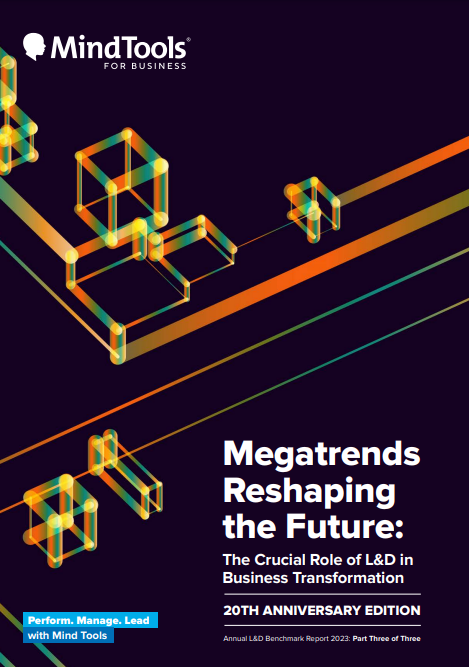📨 L&D Mixer | 😍 Join the Community | 🤖 ChatGPT Prompts
MindTools's new report digs into how L&D is evolving to align with business goals and tackle global trends like digitalization.

*This PDF by MindTools is recommended for its educational value and is not an EDU Fellowship original work. All rights belong to the original creators.
💡 The Big Ideas
- Adapting to Change: The report emphasizes the need for L&D teams to move from traditional skill-building to creating dynamic practices that adapt to changing business environments. It's about being agile and ready for anything (like climate change and digitalization).
- The Transformation Curve: A concept referenced in the report. It serves as a roadmap for L&D professionals, guiding us from the basics to advanced strategies, and helps us understand what to keep and what to let go of as we evolve.
The Four Stages of the Transformation Curve
- Stage 1 - Optimising Training: L&D is reactive with limited technology use. Decisions are made without data, and informal learning isn't prioritized. Knowledge gaps constrain digital learning.
- Stage 2 - Taking Control: Increased business awareness and use of blended learning. L&D begins to leverage technology, but skills and confidence are still developing. Managers start influencing learning design.
- Stage 3 - Letting Go: Focus shifts to learning outcomes and data-driven decisions. Learning is applied in the workplace with multiple stakeholder input. L&D adopts a performance-consulting approach, and individuals gain a voice in their learning.
- Stage 4 - Sharing Responsibility: Emphasis on shared outcomes and analytics. Holistic user experience in formal learning and a culture of digital sharing. L&D supports rather than directs, and managers foster a learning culture.
- Balancing Human and Digital Skills: In the age of AI, the report highlights the importance of balancing critical and emotional thinking skills with digital skills. This balance is crucial for upskilling new talent effectively.
- Involvement and Feedback: Top-performing organizations involve learners and managers in designing learning approaches and solutions and actively gather feedback. This participatory approach is key to effective L&D strategies.
See MindTool's previous report here, which discusses their maturity model.
🎯 My Key Takeaways
L&D isn't an isolated function; it's a strategic partner in the organization's broader objectives. The key here is to move beyond traditional training and development models that operate in silos and instead integrate L&D into the very fabric of business strategy. This integration means every L&D initiative should have a clear line of sight to business outcomes, whether improving productivity, enhancing customer satisfaction, or driving innovation. The goal is to create a symbiotic relationship where business goals inform L&D strategies, and L&D initiatives, in turn, drive business success.
Action Steps:
- Develop Business-Aligned Learning Programs: This involves a deep dive into understanding the business's core objectives and mapping out L&D initiatives that directly contribute to these goals. For instance, if the organization aims to expand into new markets, L&D programs could focus on cross-cultural communication and market-specific knowledge.
- Establish Regular Alignment Meetings: These meetings are crucial for maintaining a strong alignment between L&D and business strategies. They serve as a platform for L&D leaders to stay updated on business changes, challenges, and priorities and to discuss how L&D can best support these areas.
- Create Cross-Functional L&D Teams: By having specialized teams within L&D that align with different business functions, there's an opportunity for more tailored and relevant learning solutions. These teams can work closely with respective departments, understanding their unique needs and challenges and developing training programs that are both timely and impactful.



